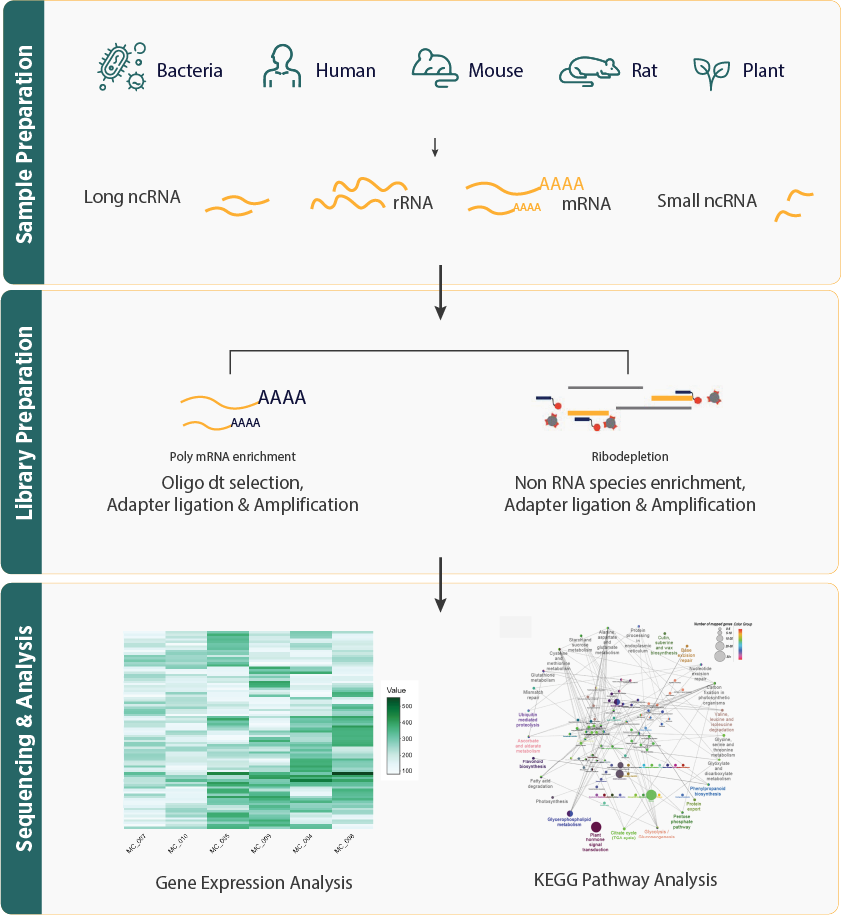Whole Transcriptome (Total RNA) Sequencing
Introduction and Workflow
- Whole Transcriptome Sequencing (WTS) comprehensively captures and quantifies all RNA transcripts, both coding (mRNA) and long non-coding (rRNA, tRNA), providing an in-depth view of gene expression.
- This method combines a ribosomal RNA depletion strategy with Illumina NGS technology for efficient and precise results. The approach (1) reduces ribosomal contamination and increases the proportion of uniquely mapped reads, and (2) is particularly beneficial for species, such as bacteria, whose mRNA may lack a poly-A tail.
- The bioinformatics pipeline includes data preprocessing, genome mapping, transcript identification, and downstream analyses like differential expression analysis, lncRNA target gene analysis, GO enrichment analysis, and KEGG enrichment analysis.
- This technique is applicable to a wide range of species, including humans, mouse, rat, other animals, plants, and prokaryotes. It is compatible with various samples like; high and low-quality RNA samples, cell-free RNA, formalin-fixed paraffin-embedded (FFPE) tissues and RNA.
Advantage
- Enables the identification of novel transcripts, alternative splicing events, post-transcriptional modifications, and gene fusions without prior knowledge, making it ideal for exploratory research.
- Analyzing the entire transcriptome helps gain a deeper understanding of gene regulation, cellular responses, and pathways, leading to a more comprehensive view of biological processes.
- Enables allele-specific gene expression analysis, offering valuable insights into gene regulation and genetic variability.
- Facilitates higher detection rates of gene fusions, indels, SNPs, and other genetic variations, offering greater reliability in research outcomes.
- Widely used in fields such as cancer research and developmental biology, WTS uncovers complex molecular mechanisms and aids in the discovery of potential biomarkers.
- Provides valuable insights into bacterial gene expression, helping to unravel the mysteries of gene regulation, host-pathogen interactions, antibiotic resistance, and the underlying causes of various diseases.

Bioinformatics Pipeline

Applications of Whole Transcriptome Sequencing (WTS)
- Developmental Biology- Explores gene expression changes during development, providing insights into cellular differentiation and organismal growth.
- Genetic Research- Enables allele-specific expression analysis, enhancing the understanding of genetic variability and gene regulation.
- Microbial Studies- Examines microbial gene expression, host-pathogen interactions, and antibiotic resistance, providing insights into microbial ecology and disease prevention.
- Human Health- Identifies gene fusions, mutations, and expression profiles in cancer, neurological disorders, and other diseases, aiding in the discovery of biomarkers and therapeutic targets.
- Immunology- Analyzes immune response pathways and gene expression in various immune cell types, contributing to improving our understanding of immune system function and disorders.
- Environmental Biology- Assesses the impact of environmental changes on gene expression in plants, animals, and microbes, aiding in ecological and evolutionary studies.
- Plant Genomics- Investigates gene expression during growth, stress responses, and development, aiding in crop improvement and understanding plant-environment interactions.
- Animal Genomics- Explores gene regulation, development, and disease mechanisms across various animal species, contributing to veterinary research and comparative genomics.
Service Specifications
Sample Requirement
Total RNA ≥ 2 μg, Minimum Quantity: 500 ng, Concentration≥ 50 ng/µL
Cells, Tissue and other samples
Please refer to sample submission guidelines or Contact Us!
Sequencing Platform
Illumina NovaSeq 6000/ NovaSeq X Plus

Deliverables
- The original sequencing data
- Experimental results
- Bioinformatics and Data Analysis Report
- Details in Total RNA Sequencing for your writing (customization)
